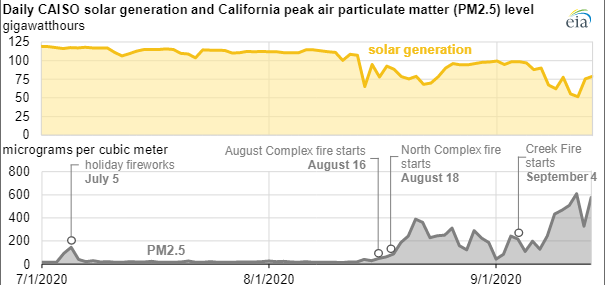Smoke From California Wildfires Decreases Solar Generation in CAISO
The U.S. Energy Information Administration (EIA) has published new data showing that smoke from wildfires in California have diminished electricity generation from the state’s solar panels. According to the agency:
In the first two weeks of September 2020, average solar-powered electricity generation in the California Independent System Operator (CAISO), which covers 90% of utility-scale solar capacity in California, declined nearly 30% from the July 2020 average as wildfires burned across the state.
Wildfire smoke contains small, airborne particulate matter particles that are generally 2.5 micrometers or smaller (referred to as PM2.5). This matter reduces the amount of sunlight that reaches solar panels, decreasing solar-powered electricity generation. As of September 28, California wildfires have burned an estimated 3.6 million acres in 2020, an area about the size of Connecticut.
“In the first two weeks of September 2020, solar-powered generation in CAISO was 13.4% lower than at the same time a year ago, despite growth in installed solar generating capacity in California. Since September 2019, California has added 659 megawatts (MW) of utility-scale solar-powered generation capacity, increasing total solar capacity by 5.3% to more than 13,000 MW as of June 2020. “
It’s always important to remember that building electricity generation sources like wind and solar leave us at the mercy of the weather. Whether it is smoke, or a snowstorm, these events will make it more difficult to generate the electricity we rely upon every single hour of every day. Furthermore, building more wind turbines or solar panels won’t even guarantee that you will produce more electricity.
California has seen this with solar, and EIA data show Minnesota generated less electricity with wind power in 2018 compared to 2017, even though there were more wind turbines operating in 2018.

Building a grid based on sources of energy that are completely out of human control is a recipe for high costs and low reliability, which is exactly what California has. Minnesota must wake up and smell the coffee on wind and solar if we are to avoid becoming Walzifornia.
